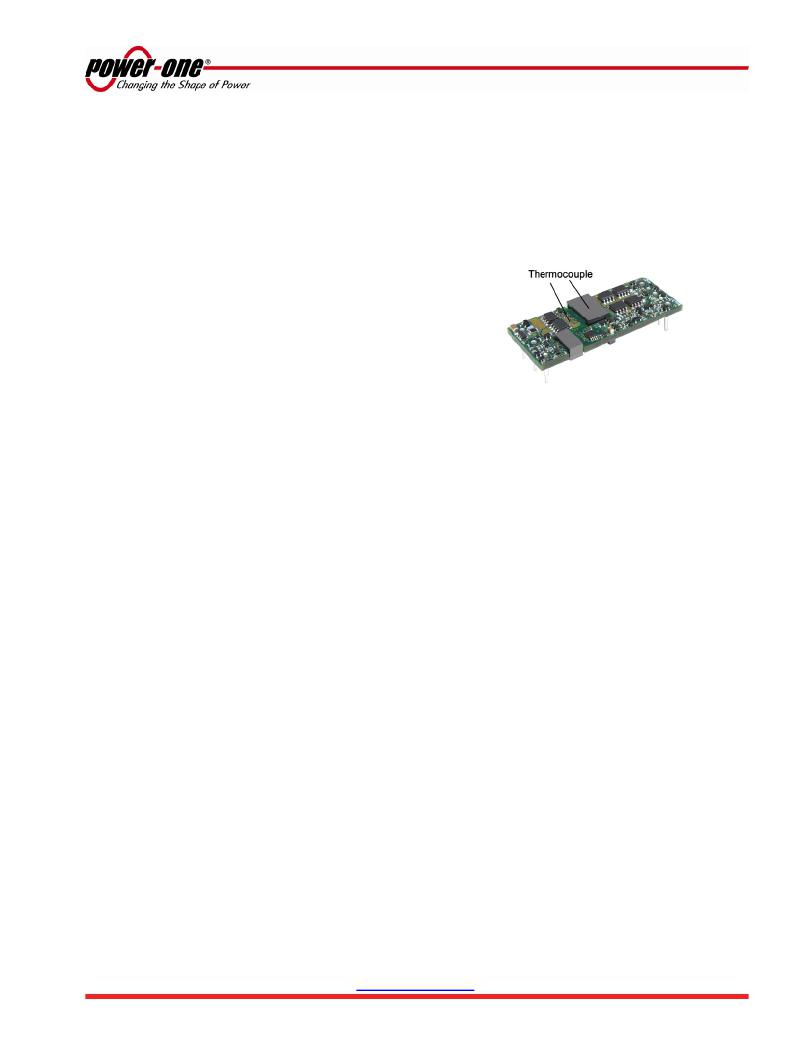- 您现在的位置:买卖IC网 > Sheet目录883 > SQE48T50012-NDA0 (Power-One)DC/DC EIGHTH BRICK
�� �
�
 �
�SQE48T50012� DC-DC� Converter�
�36-75� VDC� Input;� 1.2� VDC� @� 50� A� Output�
�Data� Sheet�
�Characterization�
�General� Information�
�The� converter� has� been� characterized� for� many�
�operational� aspects,� to� include� thermal� derating�
�(maximum� load� current� as� a� function� of� ambient�
�temperature� and� airflow)� for� vertical� and� horizontal�
�mounting,� efficiency,� startup� and� shutdown�
�parameters,� output� ripple� and� noise,� transient�
�response� to� load� step-change,� overload,� and� short�
�circuit.�
�Test� Conditions�
�All� data� presented� were� taken� with� the� converter�
�soldered� to� a� test� board,� specifically� a� 0.060”� thick�
�printed� wiring� board� (PWB)� with� four� layers.� The� top�
�and� bottom� layers� were� not� metalized.� The� two� inner�
�layers,� comprised� of� two-ounce� copper,� were� used� to�
�provide� traces� for� connectivity� to� the� converter.�
�The� lack� of� metalization� on� the� outer� layers� as� well�
�as� the� limited� thermal� connection� ensured� that� heat�
�transfer� from� the� converter� to� the� PWB� was�
�minimized.� This� provides� a� worst-case� but� consistent�
�scenario� for� thermal� derating� purposes.�
�All� measurements� requiring� airflow� were� made� in� the�
�vertical� and� horizontal� wind� tunnel� using� Infrared� (IR)�
�thermography� and� thermocouples� for� thermometry.�
�Ensuring� components� on� the� converter� do� not�
�exceed� their� ratings� is� important� to� maintaining� high�
�reliability.� If� one� anticipates� operating� the� converter�
�at� or� close� to� the� maximum� loads� specified� in� the�
�derating� curves,� it� is� prudent� to� check� actual�
�operating� temperatures� in� the� application.�
�Thermographic� imaging� is� preferable;� if� this�
�capability� is� not� available,� then� thermocouples� may�
�be� used.� The� use� of� AWG� #40� gauge� thermocouples�
�is� recommended� to� ensure� measurement� accuracy.�
�Careful� routing� of� the� thermocouple� leads� will� further�
�minimize� measurement� error.� Refer� to� Fig.� H� for� the�
�optimum� measuring� thermocouple� locations.�
�Thermal� Derating�
�Load� current� vs.� ambient� temperature� and� airflow�
�rates� are� given� in� Figure� 1.� Ambient� temperature�
�was� varied� between� 25°C� and� 85°C,� with� airflow�
�rates� from� 30� to� 500� LFM� (0.15� to� 2.5� m/s).�
�For� each� set� of� conditions,� the� maximum� load�
�current� was� defined� as� the� lowest� of:�
�(i)� The� output� current� at� which� any� FET� junction�
�temperature� does� not� exceed� a� maximum� temperature�
�of� 120°C� as� indicated� by� the� thermographic� image,� or�
�(ii)� The� temperature� of� the� transformer� does� not�
�exceed� 120°C,� or�
�(iii)� The� nominal� rating� of� the� converter� (50A� at� 1.2� V).�
�During� normal� operation,� derating� curves� with�
�maximum� FET� temperature� less� or� equal� to� 120°C�
�should� not� be� exceeded.� Temperature� at� both�
�thermocouple� locations� shown� in� Fig.� H� should� not�
�exceed� 120°C� in� order� to� operate� inside� the� derating�
�curves.�
�Fig.� H:� Locations� of� the� thermocouple� for� thermal� testing.�
�Efficiency�
�Figure� 2� shows� the� efficiency� vs.� load� current� plot� for�
�ambient� temperature� of� 25� oC,� airflow� rate� of� 300� LFM�
�(1.5� m/s)� with� vertical� mounting� and� input� voltages� of�
�36� V,� 48� V,� and� 72� V.� Also,� a� plot� of� efficiency� vs.� load�
�current,� as� a� function� of� ambient� temperature� with�
�Vin� =� 48� V,� airflow� rate� of� 200� LFM� (1� m/s)� with�
�vertical� mounting� is� shown� in� Figure� 3.�
�Power� Dissipation�
�Figure� 4� shows� the� power� dissipation� vs.� load� current�
�plot� for� Ta� =� 25� oC,� airflow� rate� of� 300� LFM� (1.5� m/s)�
�with� vertical� mounting� and� input� voltages� of� 36� V,� 48�
�V,� and� 72� V.� Also,� a� plot� of� power� dissipation� vs.� load�
�current,� as� a� function� of� ambient� temperature� with� Vin�
�=48V,� airflow� rate� of� 200� LFM� (1� m/s)� with� vertical�
�mounting� is� shown� in� Figure� 5.�
�Startup�
�Output� voltage� waveforms,� during� the� turn-on�
�transient� using� the� ON/OFF� pin� for� full� rated� load�
�currents� (resistive� load)� are� shown� without� and� with�
�external� load� capacitance� in� Figure� 6� and� Figure� 7�
�Ripple� and� Noise�
�Figure� 10� shows� the� output� voltage� ripple� waveform,�
�measured� at� full� rated� load� current� with� a� 10� μF�
�tantalum� and� 1μF� ceramic� capacitor� across� the� output.�
�Note� that� all� output� voltage� waveforms� are� measured�
�across� a� 1μF� ceramic� capacitor.�
�The� input� reflected-ripple� current� waveforms� are�
�obtained� using� the� test� setup� shown� in� Figure� 11.� The�
�corresponding� waveforms� are� shown� in� Figure� 12� and�
�Figure� 13.�
�ZD-01731� Rev� 2.0�
�www.power-one.com�
�Page� 9� of� 13�
�发布紧急采购,3分钟左右您将得到回复。
相关PDF资料
SQL48T20033-NDA0G
CONV DC-DC 3.3V 20A 1/8 BRICK
SQM48S20033-NS00
DC/DC EIGHTH BRICK
SQM48T20010-PCB0
DC/DC EIGHTH BRICK
SRBA-03A1A0G
CONV DC/DC .75-5V ADJ 3A SMD
SRBA-03E1A0G
CONV DC/DC 3A .75-5.0V SMD
SRBA-06A2A0G
CONV DC/DC .75-5.5V ADJ 6A SMD
SRBA-06F2A0G
CONV DC/DC .75-3.63VDC 6A OUTPUT
SRBC-10A2A0G
CONV DC/DC .75-5V ADJ 10A SMD
相关代理商/技术参数
SQE48T50012-NDA0G
功能描述:DC/DC转换器 1.2Vout 50A 1.2Vout 50A RoHS:否 制造商:Murata 产品: 输出功率: 输入电压范围:3.6 V to 5.5 V 输入电压(标称): 输出端数量:1 输出电压(通道 1):3.3 V 输出电流(通道 1):600 mA 输出电压(通道 2): 输出电流(通道 2): 安装风格:SMD/SMT 封装 / 箱体尺寸:
SQE5-P
制造商:Power-One 功能描述:
SQETHERNET
制造商:Intel 功能描述:
SQF620001
功能描述:OSC 156.25MHZ 3.3V HCSL SMD RoHS:是 类别:晶体和振荡器 >> 振荡器 系列:SaRonix-eCera™ SQ 标准包装:1 系列:VG-4512CA 类型:VCXO 频率:153.6MHz 功能:三态(输出启用) 输出:LVPECL 电源电压:3.3V 频率稳定性:- 工作温度:-40°C ~ 85°C 电流 - 电源(最大):60mA 额定值:- 安装类型:表面贴装 尺寸/尺寸:0.276" L x 0.197" W(7.00mm x 5.00mm) 高度:0.071"(1.80mm) 封装/外壳:6-SMD,无引线(DFN,LCC) 包装:Digi-Reel® 电流 - 电源(禁用)(最大):- 其它名称:SER3790DKR
SQF69216
制造商:Honeywell Sensing and Control 功能描述:Pressure Transducers
SQF71K0J1453
功能描述:金属膜电阻器 - 透孔 SQF7 1K0 5% 145C 3A (METAL FILM) RoHS:否 制造商:IRC 电阻:63.4 kOhms 容差:1 % 功率额定值:100 mW 电压额定值:200 V 温度系数:100 PPM / C 端接类型:Axial 工作温度范围: 尺寸:2.3 mm Dia. x 6.4 mm L 封装:Bulk
SQF-P10
制造商:ADVANTECH 制造商全称:Advantech Co., Ltd. 功能描述:Advantech Industrial CompactFlash
SQFP100
制造商:ROHM 制造商全称:Rohm 功能描述:LSI Assembly